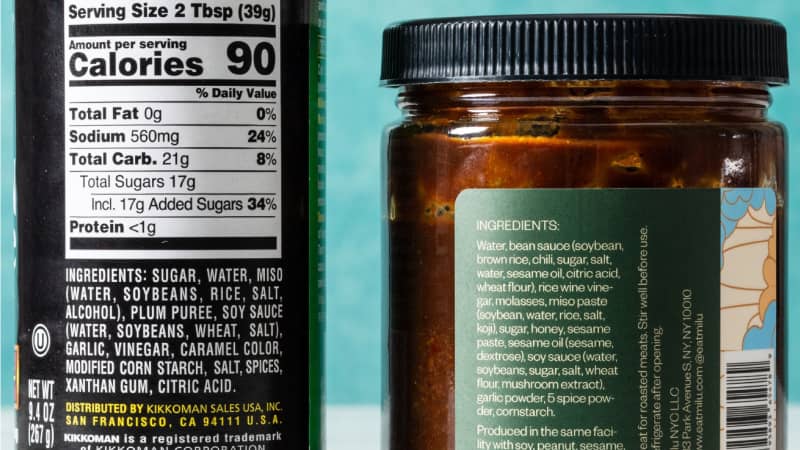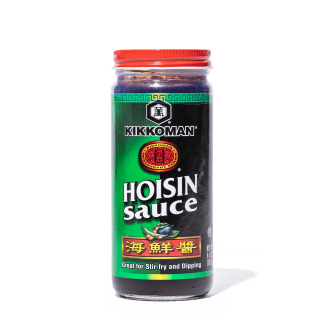Hoisin sauce (haixianjiang) was one of the first Chinese pantry staples to make a foray into mainstream American cooking. It’s fruity, tangy, and savory with a hint of spice. Its name means “seafood sauce” in Chinese, but today’s hoisin sauce doesn’t contain any seafood nor is it explicitly used for cooking seafood. How did hoisin sauce become such a versatile and iconic ingredient and what should you know when you shop for it?
The History of Hoisin Sauce
The origin of hoisin sauce can be linked to “triumphant sauce,” an ingredient favored by the Hakka Chinese people in Guangdong (also known as Canton) province for preparing fish, according to the Chinese sauce manufacturer Lee Kum Kee. The Chinese word for triumphant (“hoi syun”) sounds similar to the word for seafood (“hoi sin”), and at some point the name “hoisin sauce” caught on and stuck. People from older generations in Guangdong province recall buying hoisin sauce from street vendors selling it in large vats at the market, says Christopher Thomas, one of the creators of Chinese Cooking Demystified, a popular YouTube channel. “These vendors likely would have purchased hoisin in bulk from artisanal producers and stored it in those containers to sell loose, as is still common with some other products today” such as tofu and cooking wine. No recipe from those early days remains, so what constituted the original “hoisin sauce” is murky.
...its flavor profile, which has some deeply umami richness that comes from its key ingredient fermented yellow soybean paste, “appeals to the American palate,” contributing to its success in the U.S. market.
As early Chinese immigrants to the United States mainly came from Guangdong, “they probably brought this shelf-stable sauce with them,” says Sarah Leung of The Woks of Life, a popular food blog specializing in Chinese cooking. She added that its flavor profile, which has some deeply umami richness that comes from its key ingredient fermented yellow soybean paste, “appeals to the American palate,” contributing to its success in the U.S. market.

As hoisin sauce expanded beyond the culinary boundary of its country of origin, it has become ubiquitous. You can spot it as a condiment with Vietnamese phở and in restaurants around the world. Because hoisin was one of the first Chinese sauces to become widely available in America, it has stood in for other ingredients over the years. Beijing roasted duck, for example, is traditionally served with tianmianjiang, a sweet and slightly tangy sauce from northern China. This harder-to-procure sauce shares a similar flavor with hoisin, so restaurants often subbed it in instead.



Hoisin sauce is a mainstay in a number of iconic Chinese dishes, such as General Tso’s Chicken, Chinese barbecue spareribs, and char siu.
Hoisin sauce is sometimes referred to as “Chinese barbecue sauce.” It shines when used alone or with other ingredients in a marinade or glaze. Just a dollop can add tang and umami to a quick stir-fry and classics such as General Tso’s Chicken. Hoisin sauce is also the backbone of time-honored favorites such as Cantonese roasted duck, char siu, and Chinese barbecue spareribs. We use it for quick, flavorful pork tenderloin or flank steak. In all of these dishes, it provides depth of flavor and a luscious, glossy appearance.
The Wide Range of Hoisin Sauce
As one of the most readily available Asian sauces in America, there are many options to choose from. We purchased nine from major manufacturers and small-batch producers alike, including three gluten-free options. First, we tasted them plain and then as a dipping sauce for cheung fun. Finally, we used each to make char siu, marinating and glazing pork butts in a hoisin-based sauce.

Ingredients vary from brand to brand but we found the key components to be sugar, some form of acid (such as vinegar), and fermented soybean paste (a key ingredient responsible for imparting the deeply umami-rich savoriness). Other common ingredients we noted: salt, five-spice powder, garlic, and sesame. Some brands even add chili peppers for a spicy kick. Most contain cornstarch or potato starch, which gives hoisin its jammy consistency.

All of the sauces were deeply savory and sweet but had very different underlying flavors. Some were tangy. Others were garlicky or nutty and even smoky. They differed in color and texture too. Some were dark brown, thick, and goopy while others were caramel-colored, thin, and silky.
When using hoisin in a marinade and a glaze, we noticed their varied capabilities at adding a glossy look to the dish. The ones we most liked gave the char siu a beautiful, lacquered sheen; some others had a more muted, gray-brown color, which made the dish a tad less appealing (though still delicious). Nevertheless, tasters sang the praises of most of the sauces.

Some sauces gave the char siu a shiny, glossy appearance; some sauces dried out, leaving the exterior a bit pale.
We liked most of the hoisin sauces we tasted but identified four that we think are especially worth seeking out. Two of our favorites are widely sold at supermarkets, one is from a small producer, and one is gluten-free. Below, we’ve provided detailed descriptions of the top four hoisin sauces and everything else we tried. Read on to find the best one for your kitchen.
- Sample plain
- Sample with cheung fun (Hong Kong–style rice rolls)
- Sample in Sous Vide Char Siu
















